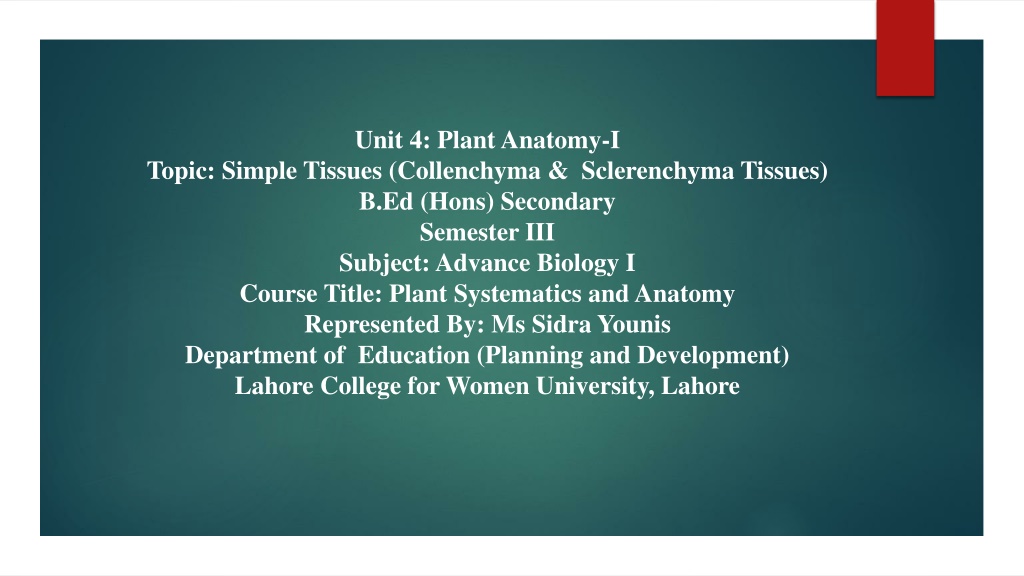Understanding Collenchyma and Sclerenchyma Tissues in Plants
Plant tissues play vital roles in providing structural support and protection. Collenchyma tissues are found in shoots and leaves, offering strength and flexibility, while sclerenchyma tissues provide rigid support in non-growing regions. Collenchyma cells have thickened corners for strength and protect plants from environmental stresses. Sclerenchyma cells are dead cells with lignin-rich secondary walls, existing as fibers and sclereids for maximum support. These tissues are crucial for plant survival and growth, representing essential components of plant anatomy.
Download Presentation

Please find below an Image/Link to download the presentation.
The content on the website is provided AS IS for your information and personal use only. It may not be sold, licensed, or shared on other websites without obtaining consent from the author. Download presentation by click this link. If you encounter any issues during the download, it is possible that the publisher has removed the file from their server.
E N D
Presentation Transcript
Unit 4: Plant Anatomy-I Topic: Simple Tissues (Collenchyma & Sclerenchyma Tissues) B.Ed (Hons) Secondary Semester III Subject: Advance Biology I Course Title: Plant Systematics and Anatomy Represented By: Ms Sidra Younis Department of Education (Planning and Development) Lahore College for Women University, Lahore
Collenchyma Tissues Collenchyma is a simple, permanent tissue typically found in the shoots and leaves of plants. Collenchyma cells are thin-walled but the corners of the cell wall are thickened with cellulose. This tissue gives strength, particularly in growing shoots and leaves due to the thickened corners. The cells are tightly packed and have fewer inter-cellular spaces.
Collenchyma Structure Function Cells are spherical, oval or polygonal in shape with no intercellular spaces. This allows for close packing to provide structural support. Corners of cell wall are thickened, with cellulose and pectin deposits. Provides mechanical strength. Cells are thin-walled on most sides. Provides flexibility, allowing plant to bend in the wind.
Functions of Collenchyma Tissues Collenchyma cells provide structural support, protecting the plant by serving as an inner framework, much like bones do for humans and other animals. Plants are exposed to numerous structural challenges and without these cells, most plants would be too fragile to withstand the damage caused by heavy rains, high winds, and other stresses. The thickened walls of the collenchyma cells enable them to provide additional support to the areas where they are found. Most notably, collenchyma cells serve growing parts of the plant, such as shoots and leaves, both by providing support and by filling in vacant spaces that will be used for later growth.
Sclerenchyma Sclerenchyma, in plants, support tissue composed of any of various kinds of hard woody cells. Mature sclerenchyma cells are usually dead cells that have heavily thickened secondary walls containing lignin. The cells are rigid and nonstretchable and are usually found in nongrowing regions of plant bodies, such as the bark or mature stems. Sclerenchyma is one of the three types of ground, or fundamental, tissue in plants; the other two types are parenchyma (living thin-walled tissue) and collenchyma (living support tissue with irregular walls). Sclerenchyma cells occur in many different shapes and sizes, but two main types occur: fibres and sclereids.
Fibers and Sclereides Fibres are greatly elongated cells whose long, tapering ends interlock, thus providing maximum support to a plant. They often occur in bundles or strands and can be found almost anywhere in the plant body, including the stem, the roots, and the vascular bundles in leaves. Many of these fibres, including seed hairs, leaf fibres, and bast fibres, are important sources of raw material for textiles and other woven goods. Sclereids are extremely variable in shape and are present in various tissues of the plant, such as the periderm, cortex, pith, xylem, and phloem. They also occur in leaves and fruits and constitute the hard shell of nuts and the outer hard coat of many seeds. Sometimes known as stone cells, sclereids are also responsible for the gritty texture of pears and guavas.
Functions of Sclerenchyma Tissues Sclerenchyma is in general the mechanical tissue. It is a thick walled tissue and provides mechanical support to the plant organs where present. The walls are lignified mostly but in some cases thickening is due to cellulose. The plant organs can withstand bending without any damage because of sclerenchyma. The cells are dead as they are absent of protoplasmic contents.

 undefined
undefined























